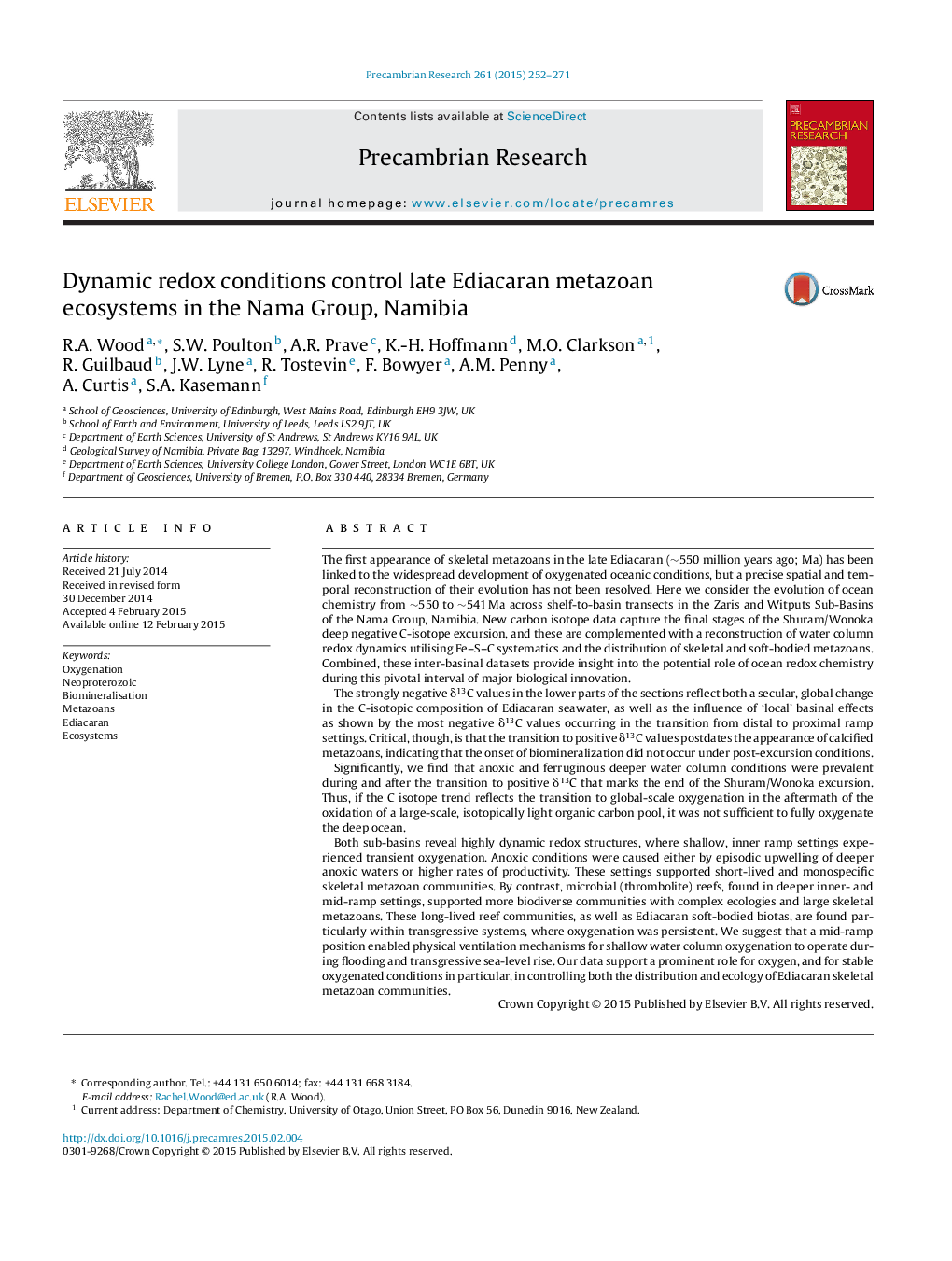| کد مقاله | کد نشریه | سال انتشار | مقاله انگلیسی | نسخه تمام متن |
|---|---|---|---|---|
| 4722723 | 1639614 | 2015 | 20 صفحه PDF | دانلود رایگان |
• New carbon isotope data capture the final stages of the Shuram/Wonoka excursion.
• The transition to positive values postdates the appearance of calcified metazoans.
• Anoxic ferruginous deeper waters were prevalent throughout this time.
• Only mid-ramp settings were fully oxygenated.
• Stability of oxygenation controlled the ecology of Ediacaran metazoan communities.
The first appearance of skeletal metazoans in the late Ediacaran (∼550 million years ago; Ma) has been linked to the widespread development of oxygenated oceanic conditions, but a precise spatial and temporal reconstruction of their evolution has not been resolved. Here we consider the evolution of ocean chemistry from ∼550 to ∼541 Ma across shelf-to-basin transects in the Zaris and Witputs Sub-Basins of the Nama Group, Namibia. New carbon isotope data capture the final stages of the Shuram/Wonoka deep negative C-isotope excursion, and these are complemented with a reconstruction of water column redox dynamics utilising Fe–S–C systematics and the distribution of skeletal and soft-bodied metazoans. Combined, these inter-basinal datasets provide insight into the potential role of ocean redox chemistry during this pivotal interval of major biological innovation.The strongly negative δ13C values in the lower parts of the sections reflect both a secular, global change in the C-isotopic composition of Ediacaran seawater, as well as the influence of ‘local’ basinal effects as shown by the most negative δ13C values occurring in the transition from distal to proximal ramp settings. Critical, though, is that the transition to positive δ13C values postdates the appearance of calcified metazoans, indicating that the onset of biomineralization did not occur under post-excursion conditions.Significantly, we find that anoxic and ferruginous deeper water column conditions were prevalent during and after the transition to positive δ13C that marks the end of the Shuram/Wonoka excursion. Thus, if the C isotope trend reflects the transition to global-scale oxygenation in the aftermath of the oxidation of a large-scale, isotopically light organic carbon pool, it was not sufficient to fully oxygenate the deep ocean.Both sub-basins reveal highly dynamic redox structures, where shallow, inner ramp settings experienced transient oxygenation. Anoxic conditions were caused either by episodic upwelling of deeper anoxic waters or higher rates of productivity. These settings supported short-lived and monospecific skeletal metazoan communities. By contrast, microbial (thrombolite) reefs, found in deeper inner- and mid-ramp settings, supported more biodiverse communities with complex ecologies and large skeletal metazoans. These long-lived reef communities, as well as Ediacaran soft-bodied biotas, are found particularly within transgressive systems, where oxygenation was persistent. We suggest that a mid-ramp position enabled physical ventilation mechanisms for shallow water column oxygenation to operate during flooding and transgressive sea-level rise. Our data support a prominent role for oxygen, and for stable oxygenated conditions in particular, in controlling both the distribution and ecology of Ediacaran skeletal metazoan communities.
Journal: Precambrian Research - Volume 261, May 2015, Pages 252–271
